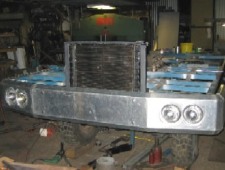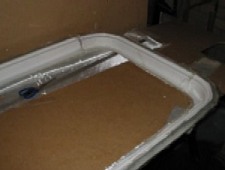Main menu
You are here
Home ›Refining the Design
5 May, 2006. Efforts to accelerate the construction process have been made during March. Our strategy involves separating the construction work into several independent work packages, and have them carried out simultaneously at different sites. For example, the rover body can be separated from the vehicle chassis, so that the latter can be moved to another site for engine refurbishment work, while work continues on the body frame. A few jobs need to be finished before that can be done properly. In particular, the body mount structures needed to be completed. For the engine work the contractor ChevyPower, who gave a very competitive quote last year, has been chosen but we want them to do more than we arranged at that time, so a new deal is being negotiated. The body frame construction is currently waiting for engineer Bruce Armstrong to finish some construction drawings for fabrication. John Byfield cannot begin this work package without these drawings. Bruce says there are still some windscreen frame issues to be resolved and he needs to re-examine one of the Mitsubishi L300 doors which are to be used as side window frames. Bruce has commenced work on composite materials molding for the cabin body. Early experiments in glass-reinforced epoxy have been quite successful. Completed test articles part of an airlock door frame and a viewport frame can be seen below. Bruce is converting his workshop into a construction site for composite plastics, and we want to have a second unit working on other components at the same time.
The exhaust system needs a customised manifold connection, which looked to be too expensive to have done by on-site exhaust contractors, so we have purchased the elbows and straight components ourselves and added this to the work to be done at Byfields. They have assured me that this is relatively easy and cheap for them to do. We can easily add the rest of the system later, by simply putting on a muffler and driving it to a exhaust shop. This should save the project some money, and keep Byfields busy while they wait for the construction drawings. Some questions to do with vibrational stresses on the cast iron manifold have now been settled, so work should be able to go ahead on that task. Project Marsupial also involves other activities, which in April have included submitting a new paper to Jon Clarke’s Mars Exploration Planning II book, touring high schools (visits to Hale and St. Joseph’s school this month) and other publicity and management jobs (eg sending the Starchaser model to Luna Park's space exhibition in Sydney). Graham and Dave Cooper also attended meeting with new science staff at Trinity College with a view to resurrecting the rover-as-a-static-simulator concept, which did not go ahead last year as planned, due to problems at the Trinity end. Graham tabled an executive summary of that idea, which helps gather resources into the project, and allows me to work on as an IT-related research project. We want to make sure we keep access to the Trinity building, and have plans to develop this into a fully equipped workshop/simulation lab, which will definitely help the project. That still requires some further funding and some volunteer weekends however.

Front of rover showing bumper and radiator mount
|

Composite epoxy airlock doorframe fresh off a test mold
|

